Transform Your Small Bathroom: Practical Design Tips
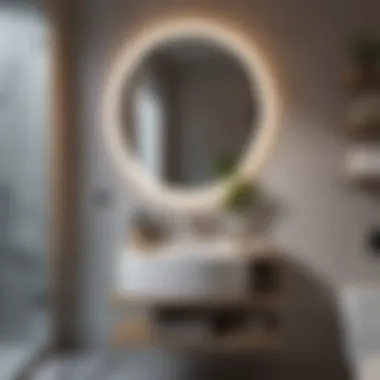
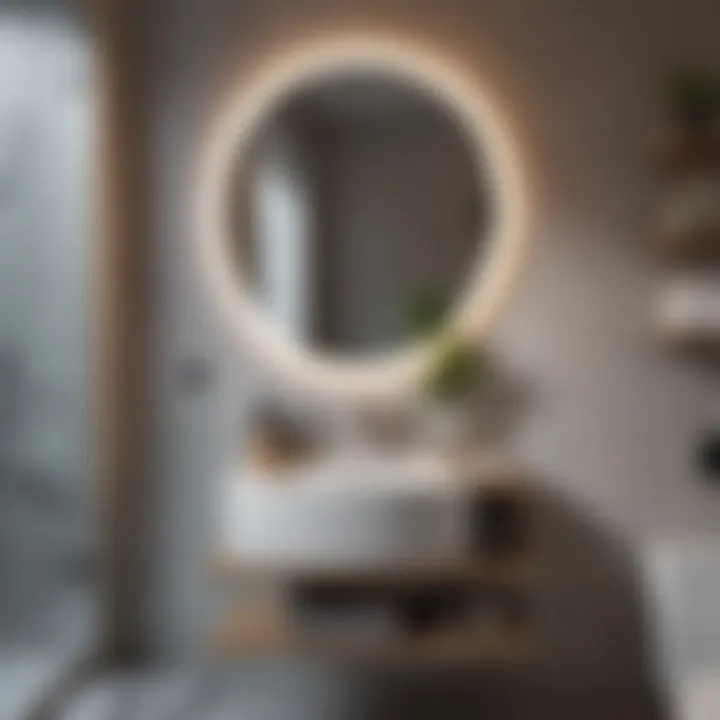
Intro
Small bathrooms often pose unique challenges. The limited space can feel constricting, and it may be difficult to balance aesthetics with functionality. However, with an understanding of practical strategies, it becomes possible to transform these compact areas into efficient and stylish spaces. This article aims to provide you with insights into optimizing small bathrooms. You will learn about layout considerations, material choices, storage solutions, lighting, and fixtures tailored to your specific needs. Whether you are a homeowner or a renter, these strategies will help maximize the potential of your small bathroom.
Design Inspiration
Current Interior Design Trends
The designs in small bathrooms evolve constantly, but certain trends prevail. Minimalism remains a popular choice as it emphasizes functionality and simplicity. Clean lines and uncluttered surfaces help create a feeling of spaciousness. Additionally, biophilic design, which brings elements of nature indoors, increases relaxation. Consider using natural materials like wood and stone to evoke a calming atmosphere.
Color Palettes and Their Effects
Color significantly impacts the perception of space. Lighter shades, such as whites and pastels, can make a bathroom appear larger and brighter. Conversely, darker colors create coziness but may feel constricting. Consider using water-based paints and non-toxic finishes to ensure healthiness in the confined space. Experimenting with color accents through accessories or tiles can also help to add personality without overwhelming.
"The right color can elevate a space not just aesthetically but also in how we feel in it."
Layout Considerations
Efficient layouts are paramount in small bathrooms. First, consider the placement of essential fixtures like the toilet, sink, and shower. Flexibility is key, with options such as corner sinks or wall-mounted toilets saving precious floor space. Another approach includes using glass partitions to separate areas visually while maintaining an open feel.
Storage Solutions
Maximizing storage is critical due to limited space. Built-in shelves, cabinets, and niches provide ample storage without occupying floor space. Consider using vertical space effectively by installing wall-mounted shelves or cabinets. Utilizing the area under the sink with organized bins can also help in keeping the essentials within easy reach.
- Mirrored cabinets serve a dual function, offering both storage and a visual expansion of space.
- Floating shelves provide surface area without bulky furniture.
- Over-the-door racks can serve as innovative solutions for housing towels or toiletries.
Lighting
Lighting plays a crucial role in the ambiance of a small bathroom. Natural lighting is often lacking, so strategic choices in fixtures and placements need careful attention. Consider layered lighting that includes ambient, task, and accent lighting. Wall sconces near the mirror can brighten up grooming areas effectively while recessed lighting in the ceiling keeps the area feeling spacious.
Fixtures and Accessories
Selecting the right fixtures can influence both aesthetics and functionality. Compact toilets, pedestal sinks, and streamlined faucets work well in limited spaces. Opt for sleek designs that reduce visual clutter. Accessories, such as stylish towel bars and storage baskets, serve both practical and decorative purposes. Incorporate multifunctional items, like a storage ottoman, which can provide seating while storing extra towels.
The End
Creating an efficient and stylish small bathroom is entirely achievable with the right strategies. Each aspect, from layout to storage, plays a vital role in transforming the space. By focusing on function while considering design trends, colors, and effective lighting, you can enhance your small bathroom into a haven of comfort and style. The steps outlined in this article provide a solid foundation for your endeavor.
Understanding the Challenges of Small Bathrooms
Small bathrooms present unique challenges that require thoughtful consideration and creativity. These spaces often feel cramped, lacking both storage and aesthetics. Knowing how to address these challenges is crucial for homeowners and renters aiming to optimize their limited area for better functionality and style. An understanding of space limitations is a foundational step. Without this grasp of dimensions and usability, one can easily overlook practical solutions that enhance a bathroom's overall effectiveness.
Identifying Space Limitations
In small bathrooms, every inch counts. The first task for anyone seeking to enhance such a space is to measure and identify the dimensions. Common measurements to note include the width of doorways, the space between fixtures, and any possible allowances for additional features. This information can reveal opportunities for adjustments or improvements. For instance, it may be advisable to consider corner sinks or floating vanities which can allow for more floor space.
Moreover, it’s important to be aware of potential obstructions like plumbing or electrical outlets which may limit your design choices. With these parameters in mind, effective planning can begin.
Common Design Pitfalls
Small bathrooms are susceptible to several design pitfalls that can hinder their usability and aesthetic appeal. One prevalent mistake is overcrowding the space with oversized fixtures or decor. Elements like large bathtubs or bulky cabinets can overwhelm a compact area, making it feel smaller than it is. When selecting fixtures, prioritize compact designs that offer functionality without sacrificing space.
Another common issue is neglecting adequate lighting. Insufficient lighting can make even the most thoughtfully designed bathroom look gloomy. It is essential to incorporate a mix of ambient, task, and accent lighting to invigorate the space.
Lastly, color choices can dramatically affect spatial perception. Dark shades without adequate natural or artificial light can trap that small feeling, while lighter tones can open up the area visually. All these factors combined underscore the need for a well-planned approach.
"Effective design in small bathrooms is not just about reducing clutter; it’s about maximizing the usability and aesthetic appeal by making the most of what you have."
By understanding these challenges and common design pitfalls, homeowners can make informed decisions that lead to more functional, stylish small bathrooms.
Layout Optimization Techniques
Layout optimization is a critical aspect of enhancing small bathrooms. The significance lies in creating a space that not only looks good but works efficiently. When you are dealing with limitations in size, every inch counts. With the right layout, it can help improve functionality while making the area feel larger and more inviting. Thoughtful planning can address common pain points such as clutter, poor circulation, and a lack of usability.
Evaluating Existing Layouts
Before making any changes, take the time to evaluate your current bathroom layout. Notice how the space flows. Is it easy to move from one area to another? Make observations on where bottlenecks may exist.
- Assess Functional Areas: Identify key areas such as the sink, shower, and toilet. Ensure they are appropriately spaced to allow ease of movement. For example, if the sink is too far from the shower, it can disrupt the routine of getting ready.
- Consider Entry Points: Check the location of doors and how they affect the movement within the space. A door that swings inward can take up valuable space. You may want to replace it with a pocket door, maximizing the usable area.
- Measure Dimensions: Accurate measurements are crucial in understanding what can fit without overwhelming the space. Knowing dimensions can help in choosing fixtures that complement the layout.
Effective Space Planning
Once you have evaluated the existing layout, it’s time to focus on effective space planning. This involves making strategic design choices that enhance usability while maintaining an aesthetically pleasing environment.
- Prioritize Essential Fixtures: Start with the essentials like toilets and sinks. Choose fixtures that are compact yet highly functional. Brands like Duravit and Kohler offer models that fit well into smaller spaces.
- Flow and Functionality: Create a smooth flow between fixtures. A common practice is to have the sink near the entry so that it is the first point of contact. This arrangement can enhance the experience of using the bathroom.
- Use Scale Drawings: Draw out a scale plan of your bathroom. This simple step allows you to visualize how different arrangements can be considered without physically moving items. It assists in experimenting with different layouts before finalizing the decision.
Incorporating these techniques can transform a cramped bathroom into a comfortable, efficient space, while minimizing wasted square footage. Strategically redesigning layouts not only enhances functionality but elevates overall aesthetics.
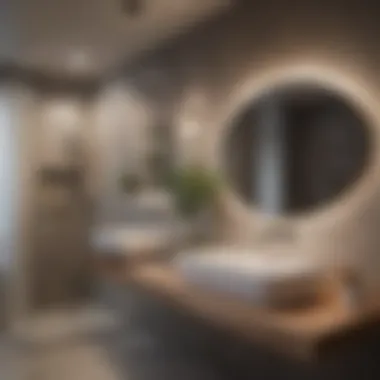
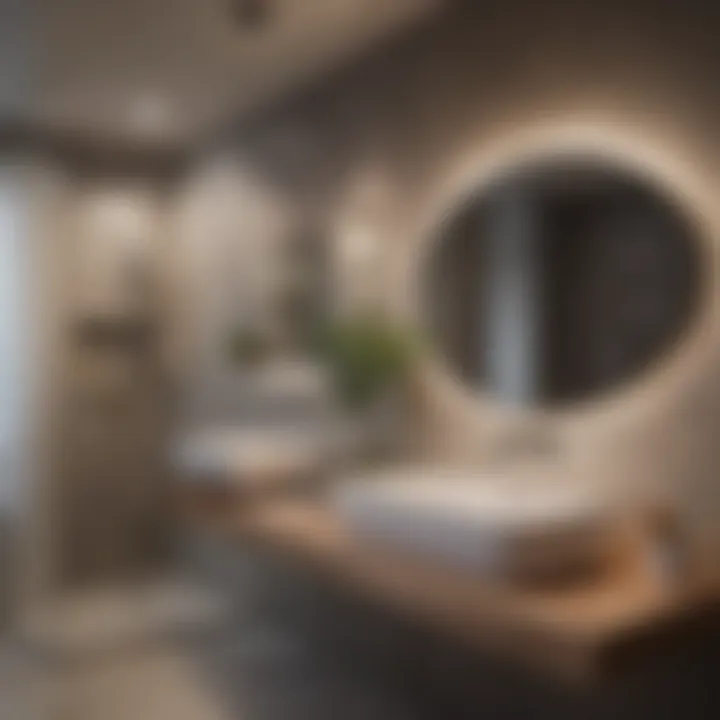
Choosing Design-Forward Fixtures
When it comes to small bathrooms, selecting the right fixtures can significantly affect both the aesthetic and functionality of the space. Design-forward fixtures revolutionize how bathrooms look and function. They maximize utility while adding modern elegance. This section will unpack the various types of fixtures, focusing on compact sinks and vanities, space-saving toilets, and the considerations between showers and bathtubs.
Compact Sinks and Vanities
Compact sinks are vital when facing space constraints. They offer functionality without overwhelming the limited area. A well-chosen sink can enhance both style and usage. Wall-mounted sinks, for instance, free up floor space, making the room appear larger. Some models come with integrated storage, merging compact design with utility.
Vanities must also be thoughtfully selected. Opting for narrow or corner vanities allows for effective use of space. The addition of drawers or shelves in these units can accommodate bathroom essentials that would otherwise clutter the area.
- Popular styles include:
- Floating vanities which elevate the look and give the illusion of more space.
- Multi-functional units that combine sink space with vanity storage.
Space-Saving Toilets
Space-saving toilets are another critical aspect of optimizing small bathrooms. The choice between various styles can affect both space usage and comfort. Consider the compact elongated bowl, which maximizes sitting area more efficiently than a round bowl, while taking up the same width.
Furthermore, opting for a one-piece toilet avoids seams that can trap dirt, facilitating easier cleaning. Models designed with a lower height cater to varying user heights and preferences, ensuring comfort for everyone.
- Features to think about:
- Dual-flush mechanisms that allow for water conservation.
- Wall-mounted toilets, which not only save space but also deploy a sleek profile.
Shower vs. Bathtub Considerations
Deciding whether to install a shower or bathtub is a considerable decision that boils down to lifestyle needs. In small bathrooms, showers often take precedence due to their functionality and reduced footprint. A shower can be built into a corner, utilizing space effectively. Many modern designs include sliding doors, which reduce necessary clearance compared to traditional swinging doors.
On the other hand, if relaxation is a priority, a bathtub might be worth the space. Selecting a compact model, such as a soaking tub, can create a spa-like atmosphere without consuming excessive space. The modern market also offers combination units, allowing for both shower and tub options in limited areas.
Innovative Storage Solutions
In small bathrooms, optimizing space is crucial for achieving a functional and aesthetically pleasing environment. Innovative storage solutions play a significant role in creating order and efficiency, allowing for better organization of necessities without overcrowding the space. Implementing these strategies can lead to a more streamlined experience, reducing the feeling of clutter. Moreover, effective storage options contribute to the overall design, enhancing the visual appeal while ensuring that every item has a designated place. This approach minimizes stress during daily routines and improves the usability of the bathroom.
Utilizing Vertical Space
Maximizing vertical space is a practical strategy in small bathrooms. As there is often limited floor area, looking upwards can unlock additional space for storage. Tall cabinets, wall racks, and hooks can all be utilized to capitalize on this often-overlooked area. This method not only frees up the floor but also draws the eyes upward, giving the illusion of higher ceilings. Additionally, it allows homeowners to make use of taller items that may otherwise be impractical in a small area.
Choosing vertical storage is quite beneficial. For instance:
- It keeps essential items easily accessible.
- It provides organization without sacrificing aesthetics.
- It can be designed to fit the style of the bathroom.
Hidden Storage Options
Hidden storage options can significantly enhance the function of a small bathroom. The main advantage of these solutions is their ability to hide clutter while still keeping items within reach. They also contribute to an overall sleek look, reducing visual distractions.
Under-sink cabinets
Under-sink cabinets are a prominent choice for maximizing storage in small bathrooms. They utilize the area beneath the sink, which is often quite expansive yet typically goes unused. By installing drawers or shelves in this space, it becomes an ideal spot for storing cleaning supplies, extra toiletries, or even towels.
A key characteristic of under-sink cabinets is their modular design. They can be customized to any sink size or style, making them a versatile option. This feature ensures a neat integration within varied bathroom environments, allowing for seamless storage solutions.
However, it is important to consider potential drawbacks. Plumbing fixtures may limit space or make some designs impractical. Additionally, maintenance is crucial as moisture can accumulate, leading to mold or deterioration over time. Ensuring proper water-resistant materials and ventilation can mitigate these issues.
Wall-mounted shelves
Wall-mounted shelves offer another effective hidden storage solution. These shelves can be placed above sinks or toilets, utilizing wall space that often remains unused. They serve not only as functional storage but also as display areas for decorative items or plants, enhancing the bathroom’s overall appeal.
A vital feature of wall-mounted shelves is their customizable height and placement. Homeowners can tailor them based on their specific needs, such as reaching everyday items without excessive bending.
That said, there are also considerations when using wall-mounted shelves. They require proper installation to ensure safety, especially if loaded with heavier items. Careful selection of materials is also essential, as certain designs may cantalever outwards, needing robust support. Despite these considerations, wall-mounted shelves remain a favorable option due to their versatility and space-saving capabilities.
In summary, innovative storage solutions are indispensable when designing small bathrooms. They not only help maximize available space but also enhance functionality and maintain an orderly environment.
Color Schemes and Material Selection
In small bathrooms, the choice of color schemes and materials plays a significant role in creating an illusion of space and enhancing functionality. The right colors can make a bathroom feel larger, brighter, and more inviting. Material selection impacts not only aesthetics but also durability and ease of maintenance. A careful balance of both is crucial for effective small bathroom design. Choosing wisely will lead to a cohesive and pleasing environment while optimizing the limited space available.
Lighter Colors to Create Illusion of Space
Lighter colors are essential when it comes to enhancing small bathrooms. Light hues, such as soft whites, pale grays, and pastels, contribute to an airy feel. These colors reflect light, brightening the space and visually expanding its boundaries. Moreover, they can provide a blank canvas that allows for flexibility in decor choices, making it easier to change accessories or accents without needing to repaint.
Consider utilizing a monochromatic color scheme, where various shades of one color are used, to maintain a sense of unity. This method keeps the space from feeling cluttered or disjointed. Implementing lighter colors on both walls and ceilings helps to merge surfaces, which can create the perception of height. The overall impact is a small bathroom that appears both spacious and uncluttered.
Texture and Material Preferences
Porcelain tiles
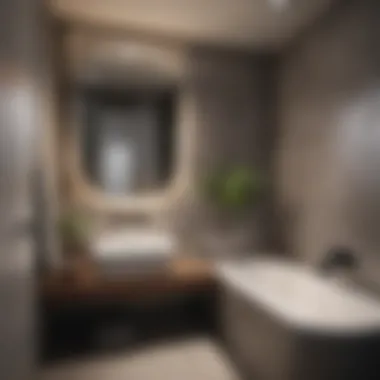
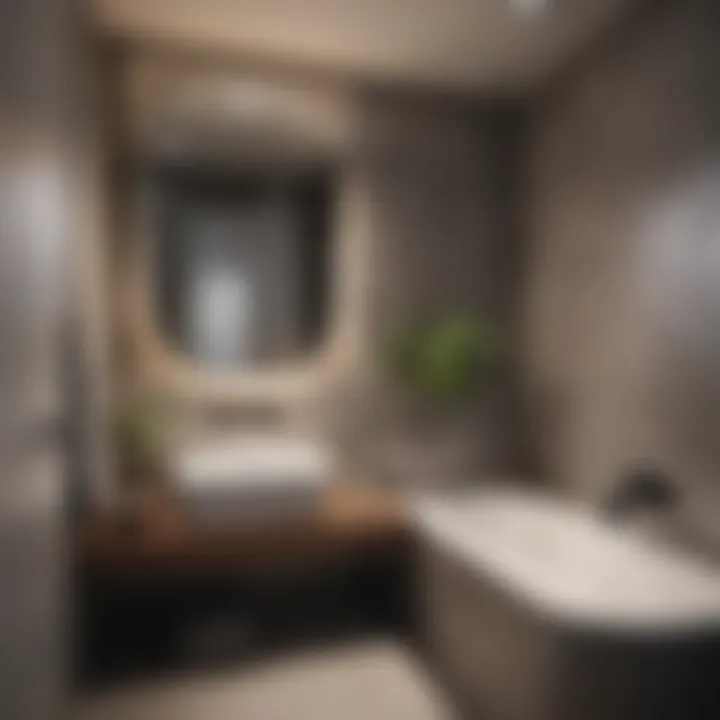
Porcelain tiles are a popular choice for bathroom flooring and wall coverings due to their durability and high resistance to moisture. This material offers an elegant look that can mimic natural stones without the associated maintenance challenges. The key characteristic of porcelain is its low porosity, making it an ideal option for spaces exposed to water.
One unique feature of porcelain tiles is their ability to come in various styles and finishes. This versatility allows homeowners to create a personalized aesthetic that fits modern or traditional designs alike. However, one drawback can be the cold surface underfoot, which can be uncomfortable without heated flooring solutions, especially in smaller spaces. Overall, the benefits of durability and design versatility make porcelain tiles a strong candidate for small bathrooms.
Water-resistant paint
Water-resistant paint is another critical aspect in enhancing small bathrooms. It is specifically designed to withstand the humidity levels typically found in these spaces. This type of paint is durable and helps prevent issues such as mildew and peeling, which are common concerns in moist environments. Choosing water-resistant paint can save time on maintenance and extend the beauty of the paint job.
A key characteristic of water-resistant paint is its easy-to-clean surface. This is beneficial for busy homeowners who seek both functionality and style. One notable disadvantage of water-resistant paint can be its higher cost compared to standard interior paints. However, the long-term savings on repairs and maintenance often justify the initial investment. Ultimately, using water-resistant paint can greatly enhance the overall longevity and appearance of the bathroom.
"Choosing light colors and high-quality materials can transform a constricted space into a sanctuary of comfort and elegance."
By thoughtfully selecting color schemes and materials, homeowners can significantly impact how a small bathroom feels and functions. Avoiding dark, heavy tones can help maintain a light, open atmosphere, while durable materials ensure practicality in everyday use.
Lighting Considerations
Lighting plays a crucial role in enhancing the functionality and aesthetics of small bathrooms. In compact spaces, effective lighting can create the illusion of more area and significantly improve the user experience. Proper lighting also highlights design features and ensures that tasks in the bathroom are performed safely and efficiently.
Importance of Natural Light
Natural light is essential in any space, especially small bathrooms. It helps in making the area feel larger and more inviting. Natural light has benefits beyond pure aesthetic value; it can positively impact mood and well-being.
When designing a small bathroom, maximizing windows or openings for natural light should be a priority. If possible, consider using frosted glass for privacy while allowing light to flow in. This allows for a bright and airy atmosphere. The presence of natural light also reduces the reliance on artificial lighting, leading to energy savings in the long run.
Layering Lighting Sources
Layering lighting sources involves combining different types of lighting to create a well-lit environment. This method is effective in small bathrooms where one source of light may fall short.
Ambient Lighting
Ambient lighting provides a general illumination to the entire space. It aims to create an overall brightness that makes the bathroom functional and comfortable. Common options for ambient lighting include ceiling-mounted fixtures or recessed lights.
One key characteristic of ambient lighting is its ability to be dispersed evenly throughout the room. This property makes it popular in bathroom design because it avoids harsh shadows. It is beneficial for daily activities like grooming or applying makeup, as it allows for a better view of oneself. While ambient lighting has many advantages, the challenge can be selecting fixtures that fit well without consuming too much visual space in a small room.
Task Lighting
Task lighting is specifically aimed at areas where precision work is done, such as above sinks or mirrors. The purpose is to provide focused light that facilitates daily tasks. Fixtures such as sconces or adjustable spotlights are commonly employed for effective task lighting.
A key characteristic of task lighting is its intensity and directionality. It provides concentrated light to areas where it is needed most, making it ideal for activities that require clarity. This type of lighting is notably a beneficial feature for small bathrooms, where visual accuracy is crucial. However, it requires careful placement to avoid creating shadows that could be distracting or unflattering.
Integrating Technology and Modern Conveniences
The integration of technology and modern conveniences in bathroom design is pivotal in enhancing both functionality and luxury in small spaces. As homeowners increasingly seek solutions that improve their daily routines, incorporating modern technology can yield significant benefits. It is not just about adding gadgets; it involves creating a seamless balance between comfort and efficiency in a restricted area.
Homeowners should focus on technologies that maximize convenience, save time, and even contribute to energy efficiency. Integrating the right technologies can transform a conventional bathroom into a sanctuary of innovation, providing homeowners with an improved experience and greater satisfaction.
Smart Shower Systems
Smart shower systems represent a significant leap in bathroom technology. These systems allow users to customize their shower experience with ease. Functions include adjusting water temperature, pressure, and even duration with a simple control panel or through a smartphone application. Some advanced systems can even remember user preferences for different family members, offering a tailor-made shower experience.
Benefits of installing smart shower systems include:
- Water Conservation: Many smart systems come with built-in timers to prevent prolonged water use, which can lead to savings on utility bills.
- Comfort: Users can program ideal water temperatures, ensuring a pleasant experience every time they use the shower.
- Accessibility: These systems are particularly beneficial for the elderly or disabled, as they often feature user-friendly controls and hands-free features.
Considerations when choosing a smart shower system include compatibility with existing plumbing, the initial investment, and whether the features align with your daily habits and preferences.
Heated Flooring Options
Heated flooring is another modern convenience that is gaining popularity in small bathrooms. This feature not only adds a layer of comfort during colder months but also creates a spa-like ambiance that can help elevate daily routines. Heated floors work by circulating warm water or using electrical heating mats beneath the tile, providing even warmth to the entire room.
The advantages of heated flooring include:
- Energy Efficiency: Heated floors can operate at lower temperatures compared to traditional heating systems, which can lead to overall energy savings.
- Increased Home Value: Homes with modern comforts like heated floors tend to attract buyers willing to invest more in property.
- Enhanced Comfort: Stepping onto a warm floor can make a significant difference in the overall experience in a bathroom, especially in the winter months.
When planning for heated flooring, it is crucial to consider installation requirements, potential disruptions during installations, and what flooring types are most suited for this technology.
Integrating these modern technologies into small bathrooms not only enhances the aesthetic appeal but also improves the overall functionality of the space. Homeowners should evaluate their needs carefully and select suitable products that will truly enhance their daily experience.
Personalizing Small Bathroom Spaces
Personalizing small bathroom spaces is essential for transforming these compact areas into functional and visually appealing retreats. A small bathroom often lacks the room to accommodate elaborate decor, making individual touches all the more crucial. Personalization not only enhances the charm of the space but also allows for a sense of ownership and comfort.
In the context of this article, the focus on personalizing small bathrooms emphasizes how personal elements can reflect lifestyle and preferences. It provides warmth and character, which are often missing in standard designs. When contemplating personal touches, consider both the aesthetics and functionality ensuring that your space is a true reflection of your personality and style.
Incorporating Personal Touches
Including personal touches in a small bathroom can make a significant impact without overwhelming the space. Simple details like family photos or art pieces can create a welcoming atmosphere. Here are a few ideas to think about:


- Customized Linens: Use towels or bath mats that represent your taste. Seasonal colors or patterns can keep the space fresh and inviting.
- Personalized Storage: Decorative boxes or baskets can store essentials while adding flair. Opt for styles that resonate with your aesthetic.
- Wall Art: Hang prints or artwork that speak to your interests. These can draw the eye and create a unique focal point.
Remember, simplicity is key in small bathrooms. Keep the number of personal items to a reasonable amount to avoid a cluttered feel.
Artful Displays
Artful displays in small bathrooms can blend functionality and style effectively. Think beyond traditional designs and integrate elements that showcase creativity. Possible options include:
- Framed Mirrors: A custom-framed mirror not only serves a practical purpose but also elevates the overall design aesthetic. Choose frames that complement your existing fixtures.
- Creative Shelving: Floating shelves can display small plants, candles, or decorative items. This approach adds visual interest while using vertical space wisely.
- Interactive Decor: Items like a plant with a unique pot can serve as both decor and air purification. This smart use of space adds life to your bathroom.
As you build your artful displays, be careful to maintain a cohesive look. Each piece should contribute to the overall theme without crowding the space.
Personalization is about reflecting who you are; it transforms a usually utilitarian area into a sanctuary of expression.
Sustainability Practices in Bathroom Design
Sustainability in bathroom design has become increasingly critical in today's world. As homeowners and designers alike seek to minimize their environmental impact, integrating sustainable practices into small bathroom designs offers both ethical and practical benefits. The main focus here is finding effective strategies that not only preserve the earth's resources but also elevate the overall bathroom experience.
Using sustainable practices reduces waste and conserves water, making bathrooms more efficient. Sustainable design also improves indoor air quality, which is essential for a healthy living environment. By selecting eco-friendly materials and fixtures, one can create a space that aligns with modern environmental standards while remaining stylish and functional. Investing time and resources into sustainability reflects a commitment to responsible living.
Eco-Friendly Materials
When considering eco-friendly materials for a small bathroom, options abound. Natural stones, reclaimed wood, and recycled products can enhance the aesthetic while also serving ecological purposes. Selecting these materials minimizes the carbon footprint associated with transportation and manufacturing processes.
Some noteworthy eco-friendly materials include:
- Bamboo: Fast-growing and renewable, suitable for cabinets and flooring.
- Recycled Glass: Used for tiles and countertops, providing unique designs and reducing landfill waste.
- Cork: Harvested without killing the tree, excellent for flooring and wall coverings.
- Low-VOC Paint: Reduces harmful emissions and improves air quality.
By choosing these materials, one does not have to sacrifice beauty for sustainability. Instead, these elements become a hallmark of a conscientious design approach.
Water-Saving Fixtures
Water conservation is a significant aspect of sustainable bathroom design. Selecting water-saving fixtures reduces water consumption, directly benefiting the environment and lowering utility bills. These fixtures are designed to maintain functionality while minimizing water usage, which is crucial in small bathrooms where every drop counts.
Consider the following water-saving fixtures:
- Low-flow Toilets: Effective in reducing water per flush without compromising performance.
- Aerated Faucets: Mix air with water to reduce flow rate while maintaining water pressure.
- Water-efficient Showerheads: Designed to use less water without sacrificing the shower experience.
By integrating these products, homeowners can reap immediate financial benefits while contributing to broader environmental goals. The transition to sustainable choices is not only advantageous but essential for responsible design in modern living environments.
"Adopting sustainability practices in bathroom design is not just an option — it's vital for preserving our planet for future generations."
Through careful selection of materials and fixtures, small bathrooms can become models of eco-friendliness. With an increased focus on sustainability, every choice made can contribute to creating a space that is not only efficient and beautiful but also respectful of our environment.
Maintenance Tips for Small Bathrooms
Maintaining a small bathroom is essential not only for aesthetics but also for hygiene. A clean and well-maintained bathroom contributes to the overall health of a household by preventing the build-up of bacteria and other harmful pathogens. Moreover, regular maintenance can prolong the lifespan of fixtures and materials, preserving the integrity of the space. Homeowners and renters alike should prioritize a maintenance routine, ensuring that their small bathrooms remain functional and inviting.
Regular Cleaning Strategies
Keeping a small bathroom clean involves a consistent routine. Start with a weekly cleaning schedule that targets all areas of the bathroom. Here are some strategies to incorporate:
- Surface Wipes: Use disinfectant wipes on counters, sinks, and toilet areas. This action prevents the accumulation of grime.
- Regular Scrubbing: Dedicate time each week to scrub tiles, tub, and sink. Hard water stains and soap scum can build up quickly due to confined space.
- Floor Care: Sweep and mop the floor frequently. Make sure to use a mop that can reach corners and under fixtures where dust and grime may accumulate.
- Mirror Maintenance: A simple glass cleaner can make a huge difference in visibility. Clean mirrors regularly to avoid streaks and spots that can make the space appear dingy.
Adopting these strategies ensures that the bathroom remains a pleasant environment. Taking time to clean these spaces results in less hassle when deep cleansing or organizing the area later.
Preventing Mold and Mildew
The moisture-laden environment of a bathroom creates ideal conditions for mold and mildew growth. This problem can lead to serious health issues, especially for those with allergies. Here are effective ways to prevent this threat:
- Ventilation: Ensure that your bathroom has proper ventilation. Use exhaust fans during and after showers to help remove moisture. If a fan is unavailable, consider leaving a window open intermittently.
- Seal Grout Lines: Grout can collect moisture, creating a breeding ground for mold. Apply a high-quality grout sealant to prolong its lifespan and reduce water penetration.
- Regular Inspections: Routinely check for leaks around sinks, toilets, and the tub. Address any plumbing issues promptly to avoid excess moisture.
- Dry Surfaces Promptly: After showering, use a squeegee to remove water from the walls and tiles. This simple habit can significantly decrease moisture levels.
By implementing these practices, you protect not only your bathroom but also the health of your household. A commitment to cleanliness and prevention can have lasting positive effects, making small bathrooms both functional and enjoyable.
Final Thoughts on Small Bathroom Design
In the journey of transforming small bathrooms into functional and visually appealing spaces, it becomes clear that careful planning and strategic choices are vital. The amalgamation of aesthetic appeal and practicality defines the essence of small bathroom design. As highlighted throughout this article, there are numerous elements that contribute to a successful layout and overall experience in a restricted area.
Choosing appropriate fixtures is essential, as they not only dictate the function but also influence the visual weight of the room. Fixtures designed for compact spaces, like those from brands such as American Standard or Kohler, can enhance usability without compromising style. Likewise, the selection of color schemes and materials plays a significant role in creating an illusion of space. Lighter palettes and reflective surfaces can enrich the small bathroom experience, making it feel more open and inviting.
Moreover, storage solutions cannot be overlooked. Utilizing vertical space and incorporating hidden storage options can significantly declutter the environment, which is key for smaller areas. In a small bathroom, every inch counts, and clever design can maximize both the visual and functional aspects of the space.
"The ultimate goal of small bathroom design is to create a harmonious balance of style and functionality."
Lighting also deserves special attention. Implementing layered lighting can create depth and highlight the design elements present within the bathroom. Natural light should be maximized as much as possible, as it can make a space feel larger while adding warmth to the overall atmosphere.
The considerations outlined emphasize that small bathrooms do not have to sacrifice elegance for space. Careful selection of fixtures, colors, lighting, and storage enhances both functionality and style. Homeowners and design enthusiasts can take these insights to realize the full potential of their small bathrooms, elevating them into spaces that offer comfort and sophistication.
Reflecting on Functionality and Style
The interplay between functionality and style is central to the design of any small bathroom. Practical considerations often guide the decision-making process, yet the desire for a pleasing aesthetic cannot be overlooked.
When reflecting on functionality, it is crucial to analyze how each element in the bathroom serves its purpose. For example, choosing space-efficient vanities or sinks that allow for maneuverability can greatly enhance the user experience. Additionally, the organization of the small space will determine how well it meets daily needs without feeling cramped.
Conversely, the element of style cannot be treated as an afterthought. Integrating design-forward fixtures that complement the overall theme will create a cohesive look. Decisions around finishes, patterns, and color choices contribute significantly to the final appearance.















